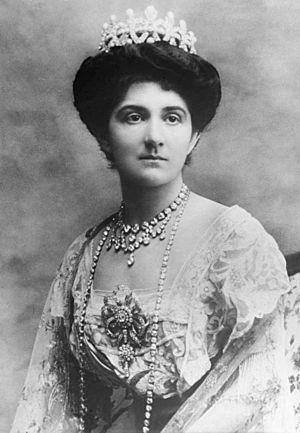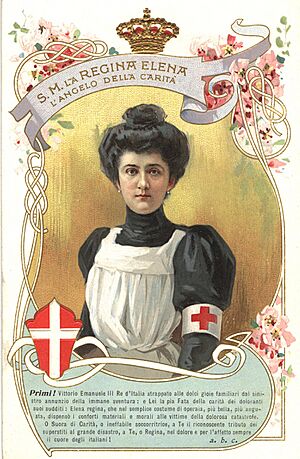Elena of Montenegro facts for kids
Elena of Montenegro (born Jelena Petrović Njegoš; January 8, 1873 – November 28, 1952) was a princess from Montenegro who became the Queen of Italy. She was the daughter of King Nicholas I of Montenegro and Queen Milena. Elena became Queen of Italy in 1900 when she married King Victor Emmanuel III of Italy.
Quick facts for kids Servant of GodElena of Montenegro |
|||||
|---|---|---|---|---|---|
| Empress consort of Ethiopia Queen consort of the Albanians |
|||||
 |
|||||
| Queen consort of Italy | |||||
| Tenure | 29 July 1900 – 9 May 1946 | ||||
| Born | 8 January 1873 Cetinje, Montenegro |
||||
| Died | 28 November 1952 (aged 79) Montpellier, France |
||||
| Burial | Sanctuary of Vicoforte | ||||
| Spouse | |||||
| Issue |
|
||||
|
|||||
| House | Petrović-Njegoš | ||||
| Father | Nicholas I of Montenegro | ||||
| Mother | Milena Vukotić | ||||
| Religion | Roman Catholic prev. Serbian Orthodox Church |
||||
| Signature |  |
||||
| Styles of Queen Elena |
|
|---|---|
 |
|
| Reference style | Her Majesty |
| Spoken style | Your Majesty |
Because Italy took over the Ethiopian Empire in 1936 and Albania in 1939, Queen Elena briefly used the titles of Empress of Ethiopia and Queen of Albania. However, her husband gave up these titles in 1943. Later, in 2001, the Catholic Church began the process to make her a saint, giving her the title of Servant of God.
Contents
Biography
Early Life and Education
Elena was born in Cetinje, which was the capital of Montenegro at the time. She grew up in a loving family where they often spoke French. They would discuss many topics, from politics to poetry.
From age six to twelve, Elena was taught by a Swiss governess named Luisa Neukomn. After that, she went to the Smolny Institute in Saint Petersburg, Russia, until she was 18. She enjoyed painting, hunting, and fishing. Elena also visited the Russian royal family and even published poems in a Russian magazine called Nedelya.
People described Elena as a shy and quiet person, but also quite determined. She loved traditions and had a kind heart. She was very curious and deeply loved nature; her favorite flower was the cyclamen. Elena was also very tall, standing at 180 cm (5 feet 11 inches).
Becoming Queen
In Italy, Queen Margherita, the mother of the future king, was looking for a wife for her son, Victor Emmanuel. She arranged for Elena to meet Prince Victor Emmanuel in Venice in April 1895.
This marriage was also a way to bring new blood into the royal families of Europe. Many royal families at the time married relatives, which could lead to health problems like hemophilia. Victor Emmanuel III's parents were cousins, so marrying Elena, who was not closely related, helped ensure their children would be healthy. Their son, Umberto II, was much taller and healthier than his father.
After another meeting in Russia, Prince Victor Emmanuel officially asked Elena's father, King Nicholas I, for her hand in marriage. They became engaged on August 18, 1896. Elena was Orthodox Christian, but she converted to Catholicism before her wedding. This was important for political reasons and to support Queen Margherita. Her father, however, was sad that she changed her religion before the wedding.
Marriage and Royal Life
Elena married Victor Emmanuel III of Italy on October 24, 1896. Her mother was so upset about Elena changing her religion that she did not attend the wedding in Rome.
On July 29, 1900, Victor Emmanuel became King of Italy after his father was assassinated. Elena then became the Queen of Italy. When Italy occupied Albania and Ethiopia, she also briefly held the titles of Queen of Albania and Empress of Ethiopia.
Queen Elena was known for being dignified but also very natural and simple. She preferred a quiet family life over grand social events. She was a loving mother who wanted her children to have a normal upbringing and not feel superior because they were royals.
In 1911, people described Queen Elena as tall and graceful. She had dark hair and bright eyes. Her skin was olive-toned, and her hands were strong. She seemed like a very strong and athletic person.
Helping Others
On December 28, 1908, a terrible earthquake hit Messina, Italy. Queen Elena immediately went to help. She visited the damaged areas and arranged for injured people to be taken to a hospital ship. She even helped care for them as a nurse. She also organized fundraising events in Rome to help the victims. This made her very popular with the Italian people.
From 1911 to 1921, Elena was the first Inspector of the Voluntary Nurses for the Italian Red Cross. She studied medicine and received an honorary degree. She used her position to help many people. She supported charities for those with brain diseases, tuberculosis, former soldiers, and poor mothers. She also worked hard to promote medical training and research to fight diseases like polio, Parkinson's, and cancer.
During World War I, Elena worked as a nurse. With the help of the Queen Mother, she turned the Quirinal Palace and Villa Margherita into hospitals. These hospitals operated from 1915 to 1919. To raise money, she created "signed photographs" that were sold for charity. After the war, she suggested selling the crown jewels to help pay off Italy's war debts. In 1920, she started a foundation to provide scholarships for children whose fathers were railway workers or soldiers who had died. She even donated some of her own jewelry to start this fund.
Because of her great faith and charity work, Pope Pius XI honored her with the Golden Rose twice, in 1930 and 1937. This was the highest honor for a Catholic lady at the time. When she died, Pope Pius XII called her a "Lady of charitable work."
During World War II
In 1939, after Germany invaded Poland and World War II began, Elena wrote a letter to six neutral European queens. She hoped to encourage them to work together to prevent the war from getting worse.
She also influenced her husband to ask Benito Mussolini, Italy's Prime Minister, to create an independent Kingdom of Montenegro in 1941. In 1943, she helped free her nephew, Prince Michael of Montenegro, and his wife from a German prison. Prince Michael had been imprisoned because he refused to become King of Montenegro under Italian protection.
On July 25, 1943, King Victor Emmanuel III had Benito Mussolini arrested. The King and Queen Elena had to leave Rome on September 9 to escape to Brindisi with the help of the Allies. Sadly, on September 23, their daughter Mafalda was arrested by the Nazis. She was sent to the Buchenwald concentration camp, where she died in 1944.
Exile and Death
After the war, on May 9, 1946, Victor Emmanuel III gave up his throne to their son, Umberto. On June 2, 1946, the Italian people voted in a referendum to become a republic instead of a monarchy. The monarchy officially ended on June 12, 1946.
Elena and Victor Emmanuel III went to Egypt, where they were welcomed by King Farouk. They had to live the rest of their lives in exile. Victor Emmanuel III died a year later in Alexandria. Elena stayed in Egypt for a short time before moving to France. In Montpellier, France, she was diagnosed with a serious form of cancer. She died in November 1952 during surgery to treat it.
65 years after her death, on December 15, 2017, Elena's remains were moved from Montpellier to the sanctuary of Vicoforte in Italy. Two days later, Victor Emmanuel III's remains were also moved from Alexandria to be buried next to hers.
Faith and Legacy
Queen Elena was recognized for her strong faith and many charitable actions. As mentioned, Pope Pius XI gave her the Golden Rose twice. In 2001, the bishop of Montpellier started the process for her beatification, which is the first step to becoming a saint in the Catholic Church. Because of this, she is now known as a Servant of God.
Children
King Victor Emmanuel III of Italy and Queen Elena had five children:
- Princess Yolanda Margherita Milena Elisabetta Romana Maria of Savoy (1901–1986), who married Giorgio Carlo, Count Calvi di Bergolo.
- Princess Mafalda Maria Elisabetta Anna Romana of Savoy (1902–1944), who married Prince Philipp of Hesse.
- Prince Umberto Nicola Tommaso Giovanni Maria of Savoy, who later became King Umberto II of Italy (1904–1983). He married Princess Marie José of Belgium.
- Princess Giovanna Elisabetta Antonia Romana Maria of Savoy (1907–2000), who married Boris III, King of Bulgaria.
- Princess Maria Francesca Anna Romana of Savoy (1914–2001), who married Prince Luigi of Bourbon-Parma.
Images for kids
See also
 In Spanish: Elena de Montenegro para niños
In Spanish: Elena de Montenegro para niños










